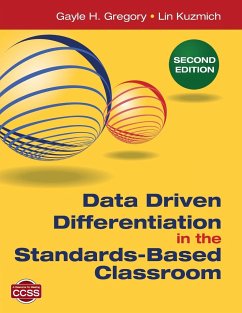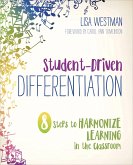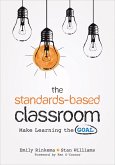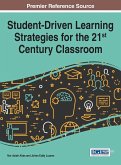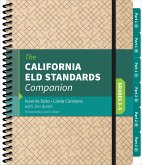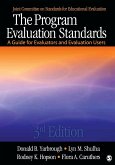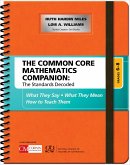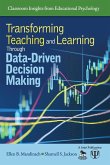- Broschiertes Buch
- Merkliste
- Auf die Merkliste
- Bewerten Bewerten
- Teilen
- Produkt teilen
- Produkterinnerung
- Produkterinnerung
Using data to plan differentiated instruction, the authors present step-by-step techniques and planning tools to help teachers design learning that allows all students to grow and achieve to their maximum potential.
Andere Kunden interessierten sich auch für
![Student-Driven Differentiation Student-Driven Differentiation]() Lisa D. WestmanStudent-Driven Differentiation29,99 €
Lisa D. WestmanStudent-Driven Differentiation29,99 €![The Standards-Based Classroom The Standards-Based Classroom]() Emily A. RinkemaThe Standards-Based Classroom48,99 €
Emily A. RinkemaThe Standards-Based Classroom48,99 €![Student-Driven Learning Strategies for the 21st Century Classroom Student-Driven Learning Strategies for the 21st Century Classroom]() Student-Driven Learning Strategies for the 21st Century Classroom188,99 €
Student-Driven Learning Strategies for the 21st Century Classroom188,99 €![The California Eld Standards Companion, Grades 3-5 The California Eld Standards Companion, Grades 3-5]() Ivannia SotoThe California Eld Standards Companion, Grades 3-547,99 €
Ivannia SotoThe California Eld Standards Companion, Grades 3-547,99 €![The Program Evaluation Standards The Program Evaluation Standards]() Donald B. YarbroughThe Program Evaluation Standards88,99 €
Donald B. YarbroughThe Program Evaluation Standards88,99 €![The Common Core Mathematics Companion: The Standards Decoded, Grades 6-8 The Common Core Mathematics Companion: The Standards Decoded, Grades 6-8]() Ruth Harbin MilesThe Common Core Mathematics Companion: The Standards Decoded, Grades 6-847,99 €
Ruth Harbin MilesThe Common Core Mathematics Companion: The Standards Decoded, Grades 6-847,99 €![Transforming Teaching and Learning Through Data-Driven Decision Making Transforming Teaching and Learning Through Data-Driven Decision Making]() Ellen B. MandinachTransforming Teaching and Learning Through Data-Driven Decision Making39,99 €
Ellen B. MandinachTransforming Teaching and Learning Through Data-Driven Decision Making39,99 €-
-
-
Using data to plan differentiated instruction, the authors present step-by-step techniques and planning tools to help teachers design learning that allows all students to grow and achieve to their maximum potential.
Produktdetails
- Produktdetails
- Verlag: SAGE Publications Inc
- 2 Revised edition
- Seitenzahl: 248
- Erscheinungstermin: 5. Juni 2014
- Englisch
- Abmessung: 280mm x 216mm x 14mm
- Gewicht: 582g
- ISBN-13: 9781483332499
- ISBN-10: 1483332497
- Artikelnr.: 40427221
- Herstellerkennzeichnung
- Libri GmbH
- Europaallee 1
- 36244 Bad Hersfeld
- gpsr@libri.de
- Verlag: SAGE Publications Inc
- 2 Revised edition
- Seitenzahl: 248
- Erscheinungstermin: 5. Juni 2014
- Englisch
- Abmessung: 280mm x 216mm x 14mm
- Gewicht: 582g
- ISBN-13: 9781483332499
- ISBN-10: 1483332497
- Artikelnr.: 40427221
- Herstellerkennzeichnung
- Libri GmbH
- Europaallee 1
- 36244 Bad Hersfeld
- gpsr@libri.de
Gayle H. Gregory is first and foremost a teacher, having experienced teaching and learning in elementary, middle, and secondary schools, community colleges, and universities. She has had extensive district-wide experience as a curriculum consultant and staff development coordinator. Gayle was principal/course director at York University for the Faculty of Education, teaching in the teacher education program. Her areas of expertise include brain-compatible learning, differentiated instructional and assessment strategies, block scheduling, emotional intelligence, student motivation, RTI Tier One, collaborative learning, common core, renewal of secondary schools, enhancing teacher quality, coaching and mentoring, managing change, and building professional learning communities. She also a trainer for Visible Learning Plus with Corwin. She is an author of numerous books related to educational neuroscience and differentiated instruction, assessment, and curriculum, including the following titles: ¿ Data Driven Differentiation in the Standards-Based Classroom, Second Edition (2014, with Lin Kuzmich) ¿ Differentiated Instructional Strategies: One Size Doesn't Fit All, Third Edition (2013, with Carolyn Chapman) ¿ Differentiated Instructional Strategies Professional Learning Guide: One Size Doesn't Fit All, Third Edition (2013) ¿ Differentiated Literacy Strategies for English Language Learners, Grades K-6 and Differentiated Literacy Strategies for English Language Learners, Grades 7-12 (2011, with Amy Burkman) ¿ Differentiated Instructional Strategies for the Block Schedule (2010, with Lynne E. Herndon) ¿ Student Teams That Get Results: Teaching Tools for the Differentiated Classroom (2009, with Lin Kuzmich) ¿ Teacher Teams That Get Results: 61 Strategies for Sustaining and Renewing Professional Learning Communities (2009, with Lin Kuzmich) ¿ Differentiated Instructional Strategies for Science, Grades K-8 (2009, with Elizabeth Hammerman) ¿ Differentiating Instruction With Style: Aligning Teacher and Learner Intelligences for Maximum Achievement (2005) ¿ The Activities for Differentiated Classroom series (2007, with Carolyn Chapman) She is affiliated with organizations such as ASCD and Learning Forward. Her ASCD publication is The Motivated Brain: Improving Student Attention engagement and Perseverance (2015, with Martha Kaufeldt). Gayle consults internationally with teachers, administrators, and staff developers. She and her family of two daughters and two granddaughters all reside in Burlington, Ontario. Gayle is committed to lifelong learning and professional growth for herself and others. She may be contacted at gregorygayle@netscape.net, www.gaylehgregory.com, and @gaylegregory6.
Preface
Acknowledgments
About the Authors
Introduction: Differentiating With Data for Student Growth and Achievement
What Is Our Target?
Challenges and Shifts Presented by the Common Core State Standards
Why Differentiate?
Theaters of the Mind: Learning Systems and the Brain
Learning Systems and Student Growth
Connecting Data to Learning
Using Classroom Data to Plan Differentiated Instructional Strategies
Targeting Growth for All Students
1. Collecting Data to Create a Positive Classroom Climate
Positive Classroom Connections
Assessing the Learning Environment
Using Feedback
Ritual, Respect, and Cultural History
Differentiating Classroom Climate
Differentiating Celebration and Praise
Summary
2. Collecting Data to Know the Learner
Going With the Flow
Learning Profiles
Different Learning Preferences
Different Intelligences
Student Contracting for Reflective Learning
Gender Differences
Cultural Differences
Pop Culture Differences
21st Century Learners and Technology
Reflections
3. Collecting and Using Assessment Data for Diagnostic Teaching
Diagnostic Teaching
Pre-Assessment
Formative Assessment
Final Assessment
Assessing Our Assessments
Summary
4. Curriculum Approaches for Data Driven Instruction
Curriculum Mapping and Data Driven Instruction
Standards-Based Unit Planning: Sample Math Unit on Data Analysis and
Probability, "The Survey Says . . . ," Grades 3 to 5
Critical Questions for Unit Planning
Pre-Assessing the Learning Gap for Unit Planning
Chunking the Learning
Summary
Other Sample Unit Plans
The Weather Reporter, Grades K to 2
Do You Know Your Rights? Grades 5 to 8
Argumentation Writing--Convince Me! Grades 9 to 12
5. Adjustable Assignments for Differentiated Learning
Options for Differentiated Learning
Adjustable Learning Grids
Adjustable Learning Elements
Flexible Grouping
Differentiating Pairs
Differentiating Small Groups
Summary
6. Instructional Strategies That Increase Student Learning
The Art and Science of Teaching
Memory Processes and the Cognitive Learning System
Differentiating Instructional Strategies
Cooperative Group Learning
Nonlinguistic Representations
Summarizing and Note Taking
Homework and Practice
Recognizing Similarities and Differences/Using Metaphors and Analogies
Summary
7. Data Driven Lesson Planning for Differentiated Learning
Using Data for Lesson Planning
Essential Elements for Data Driven Lesson Planning
Chunking the Learning for Sample Unit Plans
Summary
Conclusion: Putting It All Together for Student Growth and Achievement
How Do We Do All This Without Running From the Room Screaming?
What Can We Learn From the Errors and Successes of the Best Teachers?
What Are the Major Changes With Common Core State Standards?
Why Is It Always About the Student?
References
Index
Acknowledgments
About the Authors
Introduction: Differentiating With Data for Student Growth and Achievement
What Is Our Target?
Challenges and Shifts Presented by the Common Core State Standards
Why Differentiate?
Theaters of the Mind: Learning Systems and the Brain
Learning Systems and Student Growth
Connecting Data to Learning
Using Classroom Data to Plan Differentiated Instructional Strategies
Targeting Growth for All Students
1. Collecting Data to Create a Positive Classroom Climate
Positive Classroom Connections
Assessing the Learning Environment
Using Feedback
Ritual, Respect, and Cultural History
Differentiating Classroom Climate
Differentiating Celebration and Praise
Summary
2. Collecting Data to Know the Learner
Going With the Flow
Learning Profiles
Different Learning Preferences
Different Intelligences
Student Contracting for Reflective Learning
Gender Differences
Cultural Differences
Pop Culture Differences
21st Century Learners and Technology
Reflections
3. Collecting and Using Assessment Data for Diagnostic Teaching
Diagnostic Teaching
Pre-Assessment
Formative Assessment
Final Assessment
Assessing Our Assessments
Summary
4. Curriculum Approaches for Data Driven Instruction
Curriculum Mapping and Data Driven Instruction
Standards-Based Unit Planning: Sample Math Unit on Data Analysis and
Probability, "The Survey Says . . . ," Grades 3 to 5
Critical Questions for Unit Planning
Pre-Assessing the Learning Gap for Unit Planning
Chunking the Learning
Summary
Other Sample Unit Plans
The Weather Reporter, Grades K to 2
Do You Know Your Rights? Grades 5 to 8
Argumentation Writing--Convince Me! Grades 9 to 12
5. Adjustable Assignments for Differentiated Learning
Options for Differentiated Learning
Adjustable Learning Grids
Adjustable Learning Elements
Flexible Grouping
Differentiating Pairs
Differentiating Small Groups
Summary
6. Instructional Strategies That Increase Student Learning
The Art and Science of Teaching
Memory Processes and the Cognitive Learning System
Differentiating Instructional Strategies
Cooperative Group Learning
Nonlinguistic Representations
Summarizing and Note Taking
Homework and Practice
Recognizing Similarities and Differences/Using Metaphors and Analogies
Summary
7. Data Driven Lesson Planning for Differentiated Learning
Using Data for Lesson Planning
Essential Elements for Data Driven Lesson Planning
Chunking the Learning for Sample Unit Plans
Summary
Conclusion: Putting It All Together for Student Growth and Achievement
How Do We Do All This Without Running From the Room Screaming?
What Can We Learn From the Errors and Successes of the Best Teachers?
What Are the Major Changes With Common Core State Standards?
Why Is It Always About the Student?
References
Index
Preface
Acknowledgments
About the Authors
Introduction: Differentiating With Data for Student Growth and Achievement
What Is Our Target?
Challenges and Shifts Presented by the Common Core State Standards
Why Differentiate?
Theaters of the Mind: Learning Systems and the Brain
Learning Systems and Student Growth
Connecting Data to Learning
Using Classroom Data to Plan Differentiated Instructional Strategies
Targeting Growth for All Students
1. Collecting Data to Create a Positive Classroom Climate
Positive Classroom Connections
Assessing the Learning Environment
Using Feedback
Ritual, Respect, and Cultural History
Differentiating Classroom Climate
Differentiating Celebration and Praise
Summary
2. Collecting Data to Know the Learner
Going With the Flow
Learning Profiles
Different Learning Preferences
Different Intelligences
Student Contracting for Reflective Learning
Gender Differences
Cultural Differences
Pop Culture Differences
21st Century Learners and Technology
Reflections
3. Collecting and Using Assessment Data for Diagnostic Teaching
Diagnostic Teaching
Pre-Assessment
Formative Assessment
Final Assessment
Assessing Our Assessments
Summary
4. Curriculum Approaches for Data Driven Instruction
Curriculum Mapping and Data Driven Instruction
Standards-Based Unit Planning: Sample Math Unit on Data Analysis and
Probability, "The Survey Says . . . ," Grades 3 to 5
Critical Questions for Unit Planning
Pre-Assessing the Learning Gap for Unit Planning
Chunking the Learning
Summary
Other Sample Unit Plans
The Weather Reporter, Grades K to 2
Do You Know Your Rights? Grades 5 to 8
Argumentation Writing--Convince Me! Grades 9 to 12
5. Adjustable Assignments for Differentiated Learning
Options for Differentiated Learning
Adjustable Learning Grids
Adjustable Learning Elements
Flexible Grouping
Differentiating Pairs
Differentiating Small Groups
Summary
6. Instructional Strategies That Increase Student Learning
The Art and Science of Teaching
Memory Processes and the Cognitive Learning System
Differentiating Instructional Strategies
Cooperative Group Learning
Nonlinguistic Representations
Summarizing and Note Taking
Homework and Practice
Recognizing Similarities and Differences/Using Metaphors and Analogies
Summary
7. Data Driven Lesson Planning for Differentiated Learning
Using Data for Lesson Planning
Essential Elements for Data Driven Lesson Planning
Chunking the Learning for Sample Unit Plans
Summary
Conclusion: Putting It All Together for Student Growth and Achievement
How Do We Do All This Without Running From the Room Screaming?
What Can We Learn From the Errors and Successes of the Best Teachers?
What Are the Major Changes With Common Core State Standards?
Why Is It Always About the Student?
References
Index
Acknowledgments
About the Authors
Introduction: Differentiating With Data for Student Growth and Achievement
What Is Our Target?
Challenges and Shifts Presented by the Common Core State Standards
Why Differentiate?
Theaters of the Mind: Learning Systems and the Brain
Learning Systems and Student Growth
Connecting Data to Learning
Using Classroom Data to Plan Differentiated Instructional Strategies
Targeting Growth for All Students
1. Collecting Data to Create a Positive Classroom Climate
Positive Classroom Connections
Assessing the Learning Environment
Using Feedback
Ritual, Respect, and Cultural History
Differentiating Classroom Climate
Differentiating Celebration and Praise
Summary
2. Collecting Data to Know the Learner
Going With the Flow
Learning Profiles
Different Learning Preferences
Different Intelligences
Student Contracting for Reflective Learning
Gender Differences
Cultural Differences
Pop Culture Differences
21st Century Learners and Technology
Reflections
3. Collecting and Using Assessment Data for Diagnostic Teaching
Diagnostic Teaching
Pre-Assessment
Formative Assessment
Final Assessment
Assessing Our Assessments
Summary
4. Curriculum Approaches for Data Driven Instruction
Curriculum Mapping and Data Driven Instruction
Standards-Based Unit Planning: Sample Math Unit on Data Analysis and
Probability, "The Survey Says . . . ," Grades 3 to 5
Critical Questions for Unit Planning
Pre-Assessing the Learning Gap for Unit Planning
Chunking the Learning
Summary
Other Sample Unit Plans
The Weather Reporter, Grades K to 2
Do You Know Your Rights? Grades 5 to 8
Argumentation Writing--Convince Me! Grades 9 to 12
5. Adjustable Assignments for Differentiated Learning
Options for Differentiated Learning
Adjustable Learning Grids
Adjustable Learning Elements
Flexible Grouping
Differentiating Pairs
Differentiating Small Groups
Summary
6. Instructional Strategies That Increase Student Learning
The Art and Science of Teaching
Memory Processes and the Cognitive Learning System
Differentiating Instructional Strategies
Cooperative Group Learning
Nonlinguistic Representations
Summarizing and Note Taking
Homework and Practice
Recognizing Similarities and Differences/Using Metaphors and Analogies
Summary
7. Data Driven Lesson Planning for Differentiated Learning
Using Data for Lesson Planning
Essential Elements for Data Driven Lesson Planning
Chunking the Learning for Sample Unit Plans
Summary
Conclusion: Putting It All Together for Student Growth and Achievement
How Do We Do All This Without Running From the Room Screaming?
What Can We Learn From the Errors and Successes of the Best Teachers?
What Are the Major Changes With Common Core State Standards?
Why Is It Always About the Student?
References
Index

